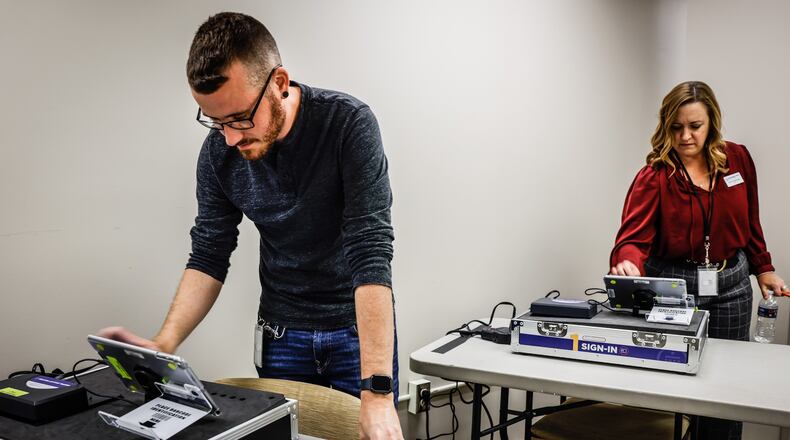Board of elections officials from Montgomery, Greene, Miami, Warren and Clinton counties joined Kenny Henning, liaison for Ohio Secretary of State Frank LaRose, at a joint news conference Tuesday at the Montgomery County Administration building to talk about the upcoming Nov. 8 election.
Henning said Ohio needs 50,000 poll workers for the Nov. 8 election and urged people to contact their local boards to sign up.
Registering, absentee ballots
The deadline for registering to vote is Oct. 11, the day before the start of early voting and absentee voting by mail. Check to see if you are registered at the secretary of state’s My Voter Information page. Registered voters who have moved must update their address by Oct. 11 to avoid having to cast a provisional ballot.
Voters can request an absentee ballot from the secretary of state’s publications page and then print out and mail the request. Applications also can be obtained by calling the county board of elections office.
Voters who don’t want to mail their absentee ballots can drop them off at the board offices or use secure drop boxes located at board offices. They can follow up on the status of their ballot by going to Ohio’s Track Your Ballot website.
“Some boards such as ours pay for tracking. We have a link on our website for the voter to track the ballot through USPS,” said Brian Sleeth, Warren County board director and president of the Ohio Association of Election Officials. “Also voters should get the USPS mail alert and can see pictures of their mail before it arrives.”
It is crucial to sign the form that comes with the absentee ballot, said Sarah Greathouse, deputy director of the Montgomery County Board of Elections. The biggest problem the board has with signatures is not that they don’t match the one on file with the office, it is that people simply forget to sign, she said.
The board will mail a form for the voter to correct the problem, but if the form is not completed the ballot can’t be counted.
Voters also need to take care to complete and return all ballot pages, said Llyn McCoy, board deputy director in Greene County, where all absentee ballots will have two pages.
“We have seen a increase in absentee requests. Right now we have 18,000 requests so far and all of the 2018 (mid-term) election we had a total of 22,400 by mail,” Sleeth said.
He said registrations are coming in at a normal pace. But Preble County Director Lisa Boggs said on Monday that her office is seeing tremendous voter enthusiasm, with an increase in voter registration and “exceptionally high” requests for absentee ballots.
“We ask those wishing to mail in their ballots to give plenty of time,” Boggs said.
Shane C. Breckel, director of the Clinton County Board of Elections, said interest in the election is comparable to 2018.
“The U.S. Senate race appears to be what voters are most interested in,” he said.
Election security critical
Officials said election security is critical.
“Election security is always at the top of the list. LaRose just issued a new security directive to all boards that must be completed before the end of the year,” Sleeth said. “There is a lot of work done in the background to make sure elections are safe and secure.”
Ohio boards have worked to improve both physical and cyber election security, Breckel said.
“We feel the security infrastructure and policies we have put into place will stand up against any threat encountered this year,” Breckel said. “We will remain vigilant and address any security concerns with confidence in our plan.”
Henning said people can see the state’s election security fact sheet online to find out what is done to make sure Ohio’s elections are safe and secure.
Among those measures: voting equipment is secure, tested and safety stored, bipartisan teams at the boards handle all ballots and voting equipment, and post-election audits are conducted to verify results.
Many area counties haven’t had many changes in voting precincts or polling places for this election, but Montgomery and Clark counties did make several changes.
“We went from 90 to 76 precincts, and from 48 to 44 polling locations,” said Amber Lopez, deputy director of the Clark County Board of Elections, who was unable to attend the meeting.
Follow @LynnHulseyDDN on Twitter and Facebook
About the Author

